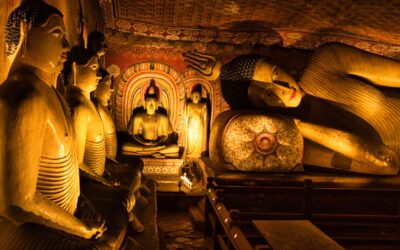Swayambhunath Stupa, also known as the Monkey Temple, is an ancient Buddhist temple located in Kathmandu, Nepal.
The temple is one of the most important and sacred Buddhist shrines in Nepal and has a rich history dating back over 2,500 years. The temple complex sits on a hilltop and is considered a pilgrimage site for both Hindus and Buddhists.
The Swayambhunath Stupa is believed to have been built more than 2,500 years ago, and it is said to have been built by the Buddhist saint, Manjushree, during the 5th century BC. It is said that Manjushree drained the water from the Kathmandu Valley, which was a lake, to build this stupa.
The stupa is built on a hilltop, and it is composed of a dome-shaped structure that is adorned with a variety of symbols, such as the eyes of the Buddha.
The dome is painted with the eyes of the Buddha, symbolizing the all-seeing nature of the Buddha and the third eye of spiritual insight.
The white dome represents the path to enlightenment, and the 13-tiered spire above it represents the 13 stages of spiritual development. The eyes are believed to symbolize the all-seeing nature of the Buddha, and remind devotees to be aware of their actions and thoughts.
The temple’s design also includes many intricate carvings, statues, and colorful prayer flags.
The Swayambhunath Stupa is a complex of many temples, shrines, and statues, including a temple of the sage Ashtasiddhi, who, according to legend, meditated on this spot.
Inside the main stupa, you can find an image of the Shakyamuni (historical Buddha) and a statue of the future Buddha, Maitreya. Also, there is a statue of the god of learning, Manjushri and other deities.
The Swayambhunath Stupa also is home to a significant number of resident monkeys, which has earned it the nickname “Monkey Temple.” These monkeys are considered sacred and are believed to have a special connection to the temple and the surrounding area.
The temple is also an important site for many festivals and events throughout the year, particularly during the full moon of the fourth month of the lunar calendar, known as the Swayambhunath Jatra, when thousands of devotees gather to circumambulate the stupa and make offerings.
Swayambhunath Stupa is a significant cultural and religious site and also a UNESCO World Heritage Site. It’s one of the most visited tourist destination in Nepal for its architecture, spiritual significance, and the lush green hilltop view from the top. It offers a unique blend of religious, cultural, and historical elements that showcase the rich heritage of the Kathmandu Valley.
One of the main attraction of Swayambhunath is the main stupa, which is open to visitors who can climb to the top for a panoramic view of Kathmandu city, it is especially great during sunsets. Additionally, visitors can take part in the traditional practice of spinning prayer wheels, which are said to bring good luck and spiritual merit.
In conclusion, The Swayambhunath Stupa is a unique and historical site where ancient tradition and culture meets the present. It’s an important pilgrimage spot for Buddhist and even for many Hindu devotees, the temple symbolizes unity and harmony among different religions and cultures. Visitors will be fascinated by its rich history, culture, and spiritual significance.


0 Comments